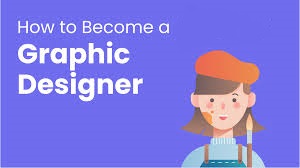- بواسطة بتول
- 10 Jun 2024
كيف تصبح مصمم جرافيك؟
"How to Become a Graphic Designer in 5 Steps" from BrainStation's Graphic Designer career guide provides a comprehensive roadmap for aspiring graphic designers. Here is a detailed summary:
Overview
The guide aims to assist individuals in starting a career in graphic design by outlining essential skills, training options, career paths, and steps to becoming a graphic designer.
Step-by-Step Guide
-
Learn Graphic Design Principles
- Importance: A solid understanding of design principles is crucial.
- Key Elements: Lines, color, shape, space, texture, typography, scale, dominance, emphasis, and harmony.
- Objective: These elements influence how an audience perceives a design.
-
Enroll in a Graphic Design Course
- Benefits: Courses teach design fundamentals, provide project-based learning, and introduce mentors and peers.
- Topics Covered: Color theory, typography, layout, graphic design tools, graphic design history, user experience (UX), and website design principles.
- Types of Courses: Options range from structured academic programs to flexible online courses.
-
Learn Key Graphic Design Tools
- Primary Tools: Adobe Creative Cloud (Adobe Photoshop, Adobe Illustrator, InDesign).
- Learning Resources: Adobe’s tutorials and user guides.
-
Work on Your Own Projects to Develop Skills
- Practice: Create mock ads and logos, redesign existing company designs, or volunteer with local non-profits.
- Objective: Gain real-world experience and refine your design skills.
-
Develop a Portfolio to Showcase Your Work
- Content: Include course projects, personal projects, and professional work.
- Focus: Quality over quantity; showcase your best work to potential employers or clients.
Types of Graphic Designers
-
In-House Graphic Designers
- Employment: Work for a single company or brand.
- Responsibilities: Design marketing campaigns, reports, and other materials.
- Work Environment: Traditional with steady paychecks and regular hours.
-
Agency Graphic Designers
- Employment: Work for agencies serving multiple clients.
- Responsibilities: Handle short-term projects for various brands.
- Work Environment: Fast-paced with high expectations for quality.
-
Freelance Graphic Designers
- Employment: Self-employed, managing design work, client relations, and administrative tasks.
- Responsibilities: Diverse projects from various clients.
- Work Environment: Flexible with the need for self-marketing and business management.
Becoming a Freelance Graphic Designer
- Learn and Practice Graphic Design
- Brand and Market Yourself
- Create a business name and online presence.
- Build and showcase a portfolio.
- Find Clients
- Use freelance job websites and personal networks.
- Overdeliver on Initial Projects
- Learn the Business of Design
- Accept Most Incoming Work Initially
- Build Your Network
- Ask for Referrals
Career Growth and Opportunities
- Industry Outlook: Growth in digital design, with a decline in print-related opportunities.
- Key Skills: Website design, animation, mobile and application design, multimedia, and virtual design.
Starting a Career in Graphic Design
- Learn Design Principles
- Enroll in a Design Course
- Master Design Tools
- Work on Projects
- Build a Portfolio
Salary Insights
- Average Salary: Around $46,000 in the US and $44,000 in Canada.
- Specializations: Motion Designers ($62,000), Web Designers ($45,000-$53,000), UI Designers ($77,000), UX Designers ($85,000).
Tips for Beginners
- Intern or Volunteer
- Work on Personal Projects
- Contact Design Agencies
- Network with Other Designers
- Develop a Specialty
- Understand User Experience (UX)
Reasons to Become a Graphic Designer
- Future-Proof Career: Graphic design requires human creativity.
- Continuous Growth: Opportunities to learn and be inspired constantly.
- Creative Freedom: Flexibility and variety in work.
- Career Opportunities: Wide range of industries and roles.
- Potential Recognition: The possibility of seeing your work publicly displayed.

